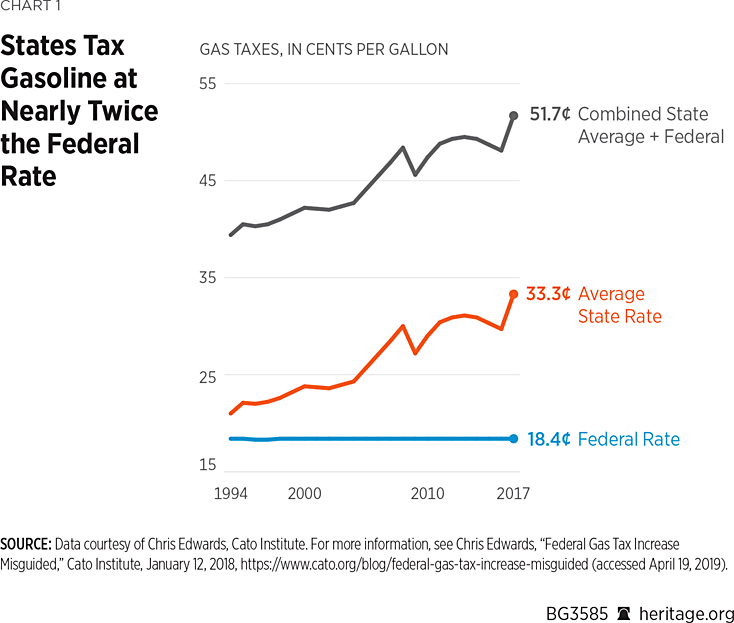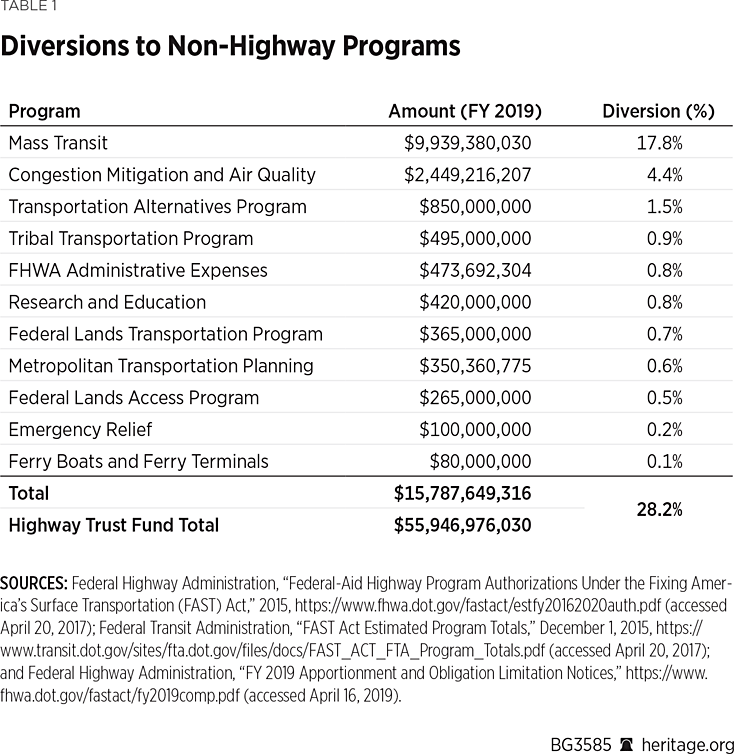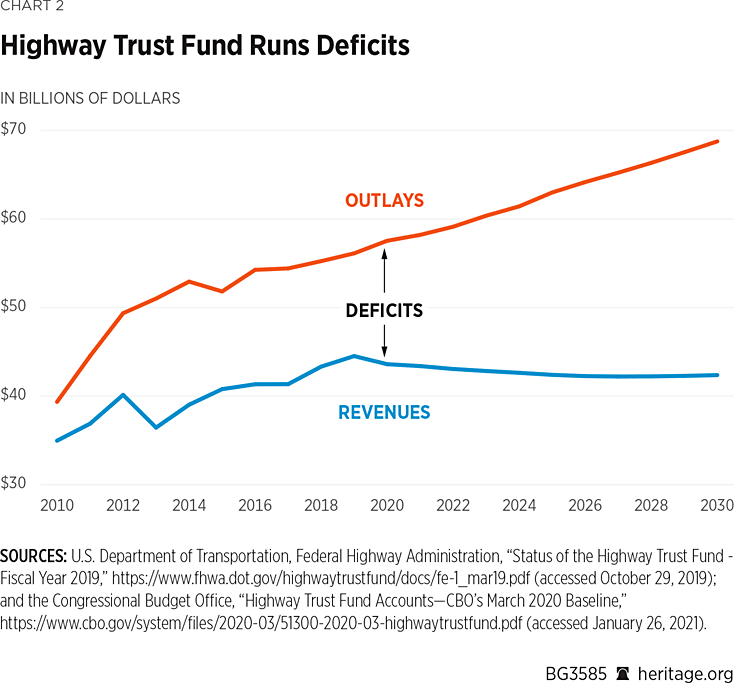Authorization for federal spending through the Highway Trust Fund (HTF) expires on September 30, 2021. While such “highway bills” typically last five years due to the long-term nature of infrastructure work, the latest reauthorization was a one-year extension included as part of an appropriations package.REF
The failure of the 116th Congress to pass a full highway bill was driven by a sharp divergence in the approaches of the House and Senate authorizing committees. The Senate’s highway bill was a bipartisan document with a mixture of flaws and improvements relative to the status quo.REF In contrast, the House put forward an ideologically driven and wildly impractical package that included highway spending, massive increases for Amtrak and other mass transit, and federal meddling in local concerns, such as drinking-water safety and school construction.REF The two chambers made little effort to bridge this policy divide during the election year and settled on punting the highway bill into the next session.
The Biden Administration has signaled that it will seek a substantial increase in heavily regulated federal spending through this year’s highway bill.REF Such a plan would add to the $27.8 trillion national debt while providing minimal value for taxpayers.REF
Rather than empowering bureaucrats in Washington, DC, to pursue ideological goals, legislators should follow these guidelines—three “do’s” and three “don’ts”—when drafting the new highway bill.
Do #1: Reform Infrastructure-Development Regulations
Excessive regulations, drawn-out litigation, and government-imposed restrictions on materials and labor are frustrations shared by many infrastructure investments. Collectively, these are obstacles to building infrastructure, drain resources, and shift spending from productive activities to unproductive ones. Rather than creating jobs by building the infrastructure that consumers want, companies must hire lawyers and consultants to navigate complex regulations and fend off legal challenges to development. Expensive, gargantuan regulatory schemes harm competition by disproportionately affecting smaller companies because they often lack the resources to navigate the regulatory process and fend off legal challenges.
The reality is that more paperwork, additional bureaucracies, and unnecessary litigation are hardly a measure of better environmental outcomes or increased safety. Instead, legislators should create more efficient processes that will affect private-sector and public-sector infrastructure development positively. These include:
- Codifying the recent Council on Environmental Quality’s (CEQ’s) National Environmental Policy Act (NEPA) reforms into law. NEPA is a half-century-old law that has not kept up with dramatic improvements in environmental quality. Beset by litigation, NEPA permitting subjects infrastructure projects to years of costly delays, when they should be expedited. If a project is not held up in the courts, it is buried in administrative purgatory. In fact, some of the most ardent NEPA critics are renewable energy developers who must contend with a multitude of regulatory barriers. Last July, the CEQ finalized reforms to modernize NEPA to establish a process for timelier infrastructure development.REF Given the other federal, state, and local environmental protections, NEPA is no longer needed and Congress should repeal the outdated law. However, codifying the CEQ’s reforms would be a welcome incremental step.
- Codifying the 2019 Endangered Species Act (ESA) regulations. The ESA has largely been an ineffective conservation tool, but it has succeeded in blocking infrastructure development and creating unintended consequences. In 2019, the U.S. Fish and Wildlife Service (FWS) and the National Marine Fisheries Service (NMFS) finalized important rules that will help with ESA implementation and do a better job of conserving endangered species. Congress should turn these reforms into law.REF
- Repealing the Davis–Bacon Act. The Davis–Bacon Act, enacted in 1931, effectively requires construction contractors for federal projects to use union-wage and union-benefit scales and follow union work rules. These rules inflate the cost of federal construction by billions of dollars per year.REF
- Prohibiting project labor agreements (PLAs). PLAs require the main contractor for government contracts to sign a collective bargaining agreement as a condition of winning a project bid. PLAs inflate construction costs by 12 percent to 18 percent in addition to increased costs that are attributed to the Davis–Bacon Act and discriminate against the 87 percent of workers who are not members of a union.REF
- Ending “Buy America” restrictions. Most federally funded infrastructure projects must comply with “Buy America” mandates, which require that certain input components be manufactured in the United States. This protectionist mandate limits selection and price competition among input manufacturers, which often leads to higher costs for infrastructure projects.REF
- Prohibiting the use of the social cost of carbon (SCC) in regulatory analysis. The federal government uses the SCC to calculate the climate benefit of abated carbon-dioxide emissions from regulations or the “climate cost” of infrastructure projects. Models used to estimate the SCC are highly subjective, and outcomes vary significantly with reasonable changes to model inputs, such as changes in discount rates. They are inadequate tools for policymaking and regulatory analysis.REF A better, more transparent metric for assessing a project’s climate impact would be to evaluate its impact on global temperatures.
Don’t #1: Repeat Obama-Era Mistake of Infrastructure as Stimulus
Infrastructure spending as an economic stimulus is an inappropriate response to the economic downturn and one of the least supportable reasons to expand federal funding in the new highway bill.
Economic stimulus programs have historically failed to jump-start economic recovery—and likely make economic recovery more difficult. Individuals and businesses react to new government programs by scaling back their private spending and shifting—rather than expanding—production, canceling out any theoretical benefits of additional government expenditures.REF Infrastructure spending is an especially ineffective stimulus because it can take years to deploy the funds, it does not create new jobs, states compensate for new federal grants by shrinking their own spending, and many projects are ultimately wasteful spending.REF
As President Barack Obama learned the hard way, infrastructure projects are rarely “shovel ready.” This means that the government money can take years to be deployed, delaying the predicted stimulus until after the economy has begun to recover. For example, many environmental reviews can take nearly five years to complete. Even ready-to-go state projects, such as the construction of two firehouses in San Antonio, Texas, met a year-long delay after federal money was involved.REF
Federal spending does not create new job opportunities, and instead reshuffles existing construction jobs within the industry. Past infrastructure stimulus did not significantly increase the number of workers on targeted projects and tended to move workers from private-sector projects to government-funded priorities.REF
Federal dollars also crowd out state and local project funding by allowing recipient governments to decrease own-source funding on infrastructure. Following the 2009 federal infrastructure package, total spending on infrastructure remained relatively unchanged as states reduced their own-source spending.REF In Maryland, for example, net state funding for transit infrastructure decreased by $90 million.REF
Federal infrastructure spending is often funneled to unproductive, wasteful projects favored by special interests. In Pittsburgh, federal funds subsidized a transit “tunnel to nowhere” for access to a casino and sports stadium instead of increasing commuter access. In California, funds were used to renovate infrastructure for a private Napa Valley wine train instead of repairing local roads.REF Better known mal-investments include the $535 million loan to the failed solar manufacturer Solyndra, and a similarly sized grant to Abound Solar, which subsequently filed for bankruptcy.REF
Do #2: Empower State and Local Governments and the Private Sector to Obtain Infrastructure Funding
Tremendous amounts of lobbying are directed at promoting federal infrastructure spending. A significant reason for this is that it can be more difficult to finance projects without federal help than it is to lobby for subsidies. It would be one thing if those difficulties were naturally occurring. However, federal policies are often the primary obstacles to non-federal infrastructure financing.
The largest federally imposed financing hurdle is a ban on tolling most interstate highways. It is important to note the carve-out in the 1956 Highway Act, which grandfathers in highways that were already tolled at the time.REF This means that states with a higher number of post-1956 highways are treated unequally and are forced to rely more on revenue sources such as gas taxes. The ban also increases demand for federal subsidies. Federal legislators should eliminate, or at least relax, rules on interstate highway tolls, which would provide state governments more means and flexibility in financing highway maintenance and operations.REF
Private infrastructure financing also receives unequal treatment. Since it takes years to complete major infrastructure projects, financing is extremely important to the viability of a project. State and local governments receive tens of billions of dollars in subsidies every year due to the federal government providing tax-free status to qualifying municipal bonds, with no limit on the number or size of bonds.REF In contrast, tax-free bonds used to finance private infrastructure projects (called private activity bonds) are capped at $15 billion, which is a small fraction of the size of the municipal bond market.REF This imbalance has often left financing of infrastructure as an afterthought, increasing reliance on taxes. The imbalance can be corrected by placing private bonds on closer footing with municipal bonds.REF
Don’t #2: Raise Federal Taxes
Raising federal taxes to fund an increase in federal infrastructure spending is unnecessary and would be economically destructive.REF New infrastructure investments should be led by the private sector and local governments, not Washington, DC. Existing federal infrastructure and funding mechanisms—such as the gas tax—should be devolved to the states.
The most significant funding source for federal infrastructure is the per-gallon tax on gasoline and diesel fuels—which currently stands at 18.4 cents and 24.4 cents, respectively. The prevailing argument from proponents of increasing the gas tax is that the tax serves as a user fee, and has not increased since 1993.REF Inflation, fuel-efficiency gains, and electric-vehicle sales have indeed led to a decline in the fixed-rate-tax’s real value.
However, at the state level, the story is just the opposite. Since 1993, average state gas-tax rates have increased from just above 20 cents per gallon to 33 cents per gallon, keeping the combined tax rate on-trend.REF The movement toward individual states’ power over their own transportation funding sources is a rare positive step away from the consolidation of power in Washington. Increasing the federal gas tax would expand the scope of federal control over state decision-making and undermine the progress made since the 1990s. The gas tax is also not an effective user fee because more than a quarter of the revenue is obligated to non-highway projects, a trend that is likely to be expanded in the 2021 highway bill.REF

Increasing the gas tax is also economically harmful, and the costs would fall disproportionately on lower-income Americans, who tend to spend larger shares of their income on gasoline. Higher gas prices mean less disposable income to save or spend, and higher business costs for transporting goods. Consequently, higher fuel prices would reduce household income, destroy jobs, and result in a weaker economy. In a 2019 report, Heritage Foundation analysts estimated that increasing the gas tax by 25 cents per gallon could lead to a peak employment shortfall of 364,000 jobs through 2040, and $469 billion in lost gross domestic product (GDP), amounting to $5,400 in lost income per family of four.REF Increasing other taxes, such as the corporate income tax, or adding a new revenue source, such as a carbon tax, would be even more harmful to the economic recovery.
Congress has also shown significant interest in developing a vehicle-miles-traveled (VMT) tax to better approximate the user-fee model and compensate for the increasing fuel efficiency of the U.S. automobile fleet. Adding a federal VMT to the federal gas tax would simply add new real and administrative costs for American families. The new revenue source would further cement and expand the federal government’s one-size-fits-all approach to the nation’s transportation infrastructure. While some states might decide to pursue VMT taxes as a more efficient local revenue source, it is not an appropriate system for the federal government to administer.REF
Do #3: Devolve Spending Decisions to State and Local Governments
The HTF was initially designed to take in revenue from the federal gas tax and send funds back to states for the construction and maintenance of the interstate highway system.REF Under the current arrangement, the federal government sends money to states based on two sets of formulas. The first formula sets the total amount a state receives based on a minimum percentage of how much of the federal gas tax comes from the state, which was implemented in an attempt to reduce cross-subsidies between states.REF The second formula is the division of HTF allotments into different programs.REF
Congress has added many non-highway programs to the fund, a trend that escalated in the 1980s.REF Over a quarter of spending from the HTF is currently diverted from the interstate system. The largest diversion is for mass transit, which receives roughly $10 billion from the HTF per year despite transit users not paying into the fund. Additional programs fund disparate projects such as bike paths, sidewalks, planning boards, and even ferry boats.REF

The interstate highway system was created to improve national defense by facilitating easier transportation of people and goods throughout the country. However, most of the diversionary programs fund projects whose benefits are localized. Further, because the funding formula is rigid, states are unable to customize HTF spending based on their needs. For example, low-density states get minimal value from programs that are designed for dense urban areas and semi-dense suburbs.
The federal role in surface transportation has mutated from spearheading a nationwide construction initiative into micromanaging and subsidizing all forms of infrastructure. Federal surface transportation spending should have diminished starting with the interstate’s official completion in 1992.
Now that nationally needed highways have been completed, the federal government can step back and focus on ensuring maintenance. Reducing highway spending and the federal gas tax would enhance the decision-making ability of states and localities to choose which projects to fund and how they are funded.REF Discarding the current one-size-fits-all federal approach would allow infrastructure to be tailored to the needs and preferences of local and regional constituencies.
Eliminating, or at least reducing, HTF spending diversions would better align the fund’s revenue with its outlays so that those who pay into the fund receive the benefits, in contrast with hidden and wasteful cross-subsidies from drivers to other modes of transportation. It would also end the practice of forcing states to spend their funds on programs with limited utility.
Don’t #3: Add to the National Debt
The HTF has suffered from chronic deficits due to Congress consistently and intentionally increasing spending higher than gas tax revenue. This trend shows no sign of abating.REF

In 2015, Congress used a $70 billion general fund transfer (deficit spending) to fund the Fixing America’s Surface Transportation (FAST) Act.REF This followed $70 billion worth of transfers from 2008 through 2015.REF In 2020, the bipartisan Senate highway bill fizzled in part due to an unwillingness to either reduce infrastructure spending or pay for it.REF
Many advocates for an increase in federal infrastructure spending have seized on the COVID-19 pandemic and the related recession as a reason to ignore HTF deficits—they want to finance the extra spending by adding to the national debt.REF This would be unwise for several reasons:
- The extra spending would exacerbate the HTF’s unsustainability by permanently increasing baseline spending. This would impose difficulties on future sessions of Congress by making it politically impossible to reconcile the gap between spending and revenue, which is already projected to exceed 50 percent of revenue within a decade.REF
- Additional federal infrastructure spending would provide minimal economic benefits (especially in the near term) and would likely retain the many regulatory and diversionary inefficiencies of the status quo. This dramatically reduces the value of the spending, which in turn means that there is not sufficient justification to increase the debt.
- The gross national debt already stands at $27.8 trillion, an astonishing $4.3 trillion increase since the pandemic took hold in March 2020.REF The Congressional Budget Office projects that baseline deficits will exceed $1 trillion per year indefinitely, and that the debt will grow much faster than the economy even after the economy recovers.REF Such unprecedented levels of peacetime debt and systemic deficits pose a serious risk to America’s financial health due to the amount of debt subject to credit market fluctuations. If markets demand higher interest rates in the future, the cost of interest payments would quickly become a severe burden on both federal finances and the economy.REF
Rather than passing the bill for infrastructure spending on to future generations, legislators should recognize the waste and inefficiency of federal activity and balance the HTF by lowering spending levels.
Conclusion
Legislators have a tremendous opportunity to improve the value of America’s infrastructure investments. Attempting to do so by throwing federal taxpayer dollars at the issue has proven to be ineffective as economic stimulus, and leads to tremendous amounts of waste, inefficiency, and delay. Cutting red tape and turning more decision-making power over to state and local governments and the private sector would enable more infrastructure projects to finish at lower cost and in less time, providing maximum economic benefits to the nation.
David A. Ditch is Research Associate in the Grover M. Hermann Center for the Federal Budget, of the Institute for Economic Freedom, at The Heritage Foundation. Nicolas D. Loris is Deputy Director of the Thomas A. Roe Institute for Economic Policy Studies, of the Institute for Economic Freedom, and Herbert and Joyce Morgan Fellow in Energy and Environmental Policy. Adam N. Michel, PhD, is Senior Analyst for Fiscal Policy in the Hermann Center.



